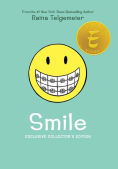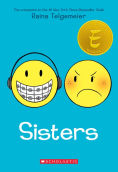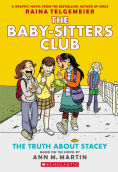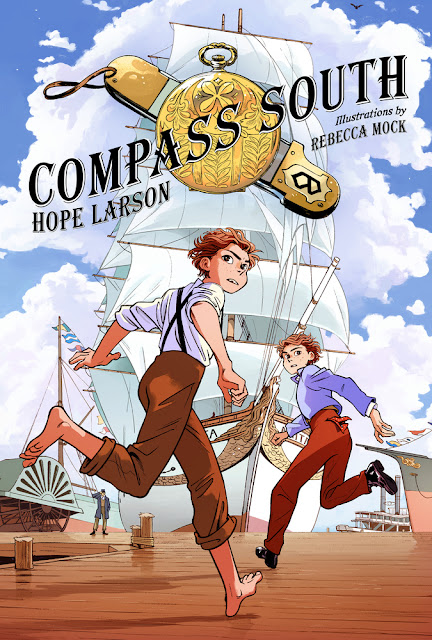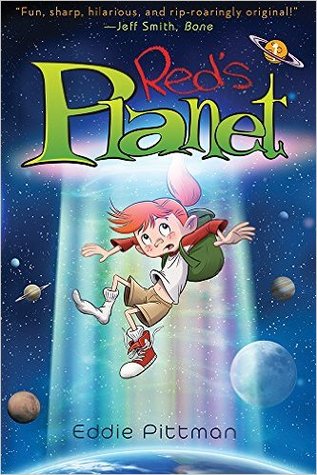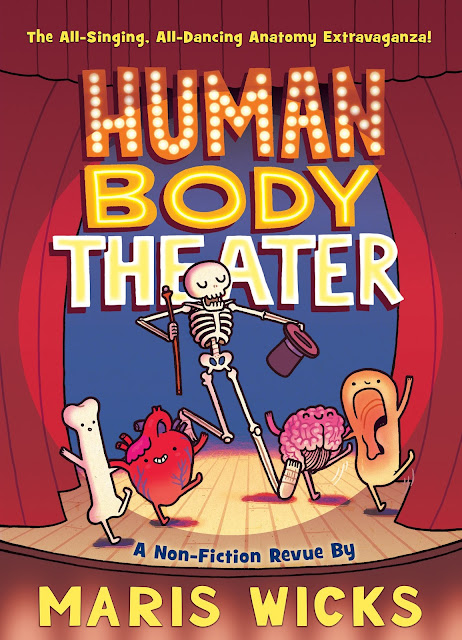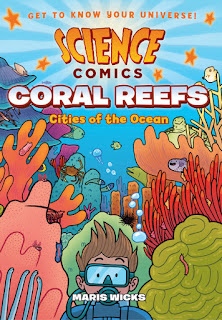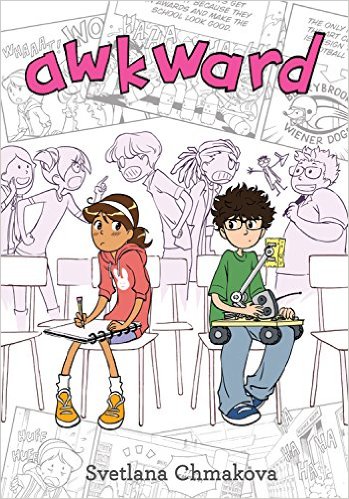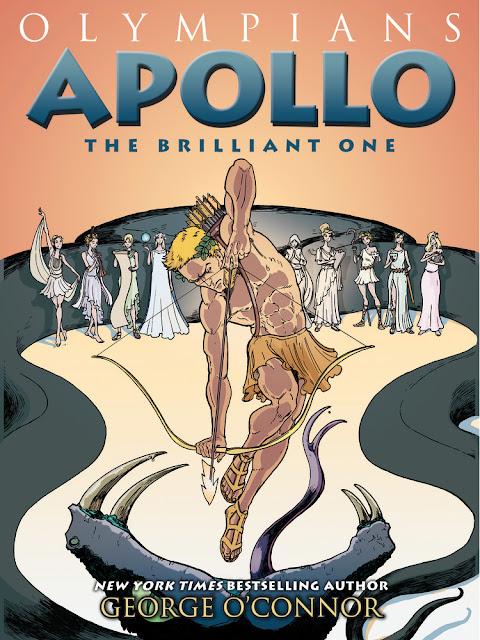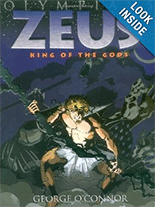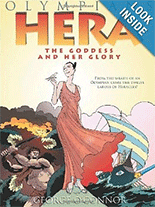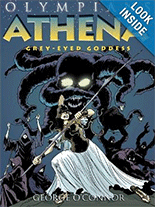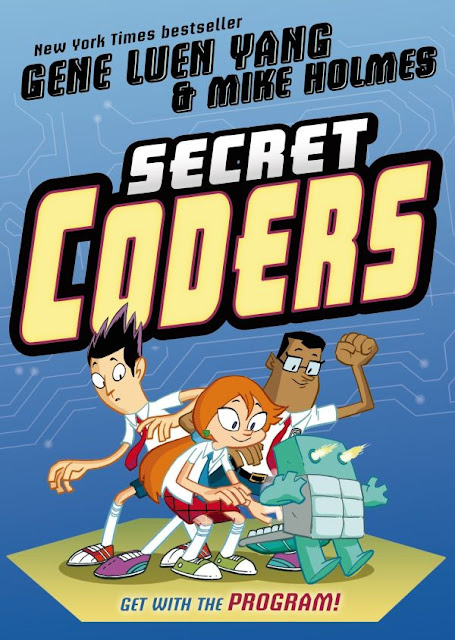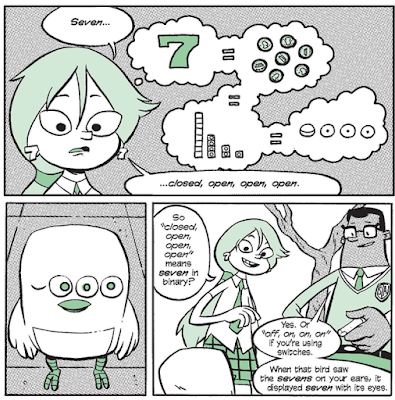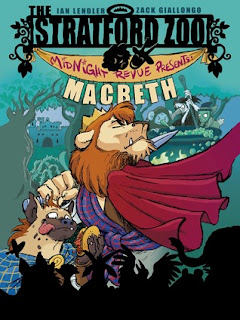new posts in all blogs
Viewing: Blog Posts Tagged with: GNRL4, Most Recent at Top [Help]
Results 1 - 23 of 23
How to use this Page
You are viewing the most recent posts tagged with the words: GNRL4 in the JacketFlap blog reader. What is a tag? Think of a tag as a keyword or category label. Tags can both help you find posts on JacketFlap.com as well as provide an easy way for you to "remember" and classify posts for later recall. Try adding a tag yourself by clicking "Add a tag" below a post's header. Scroll down through the list of Recent Posts in the left column and click on a post title that sounds interesting. You can view all posts from a specific blog by clicking the Blog name in the right column, or you can click a 'More Posts from this Blog' link in any individual post.
This summer, I discovered that Alexis Deacon, picture book illustrator, author and frequent collaborator with another favorite of mine, Viviane Schwarz, had created Geis, a graphic novel that was already on sale in the UK. I waited patiently for it to go on sale here and, when I finally got to read Geis, I was surprised, enthralled and left breathless by the beauty of the illustrations, the rich world building and the fast pace of the story. I was so sad to read the end of Geis, but, I realized half way into it that it is a trilogy, so there is more to come!

Geis begins with a definition of the word "geis," pronounced "gesh," which is a Gaelic word for a taboo or curse, "like a spell that cannot be broken and certain rules must be obeyed." In an unnamed world that is reminiscent of a Bruegel painting, the Great Chief Matarka is dying without leaving an heir. Fifty people, including the Grand Wizard, the High Priest, the Chief Judge and the Lord Chamberlain have been called to her death bed. Among them is Io, the young daughter of the Kite Lord. Matarka has devised a contest that will determine who will take her place, but Niope, an evil sorceress, using Death Magic, has taken control of the event and tricked the fifty attendees into signing their names to a cursed parchment.


The fifty attendees are hurtled to various corners of the realm by the sorceress and must return to the death chamber to prove their worthiness. Io is the first to return where she learns the horrible truth of the geis from the sorceress. Nemas is next and together, the two know the truth of the challenge the fifty souls face but are not allowed to speak of it. When they do, the curse renders them speechless. They learn that they have until the next sunrise to leave the castle and return for a challenge that will leave all but one of them dead. As Io and Nemas prepare for this battle, we see others facing their fates, some of which are horrific, with bravery and cowardice, together and alone.

Geis is over almost as soon as it starts, yet you reach the final page of this graphic novel feeling like you have been gone for much longer. This is in large part due to Deacon's amazing illustrations and masterful world building. I was reminded immediately of the work of Maurice Sendak, some of which I have shared below. Io proves to be a young but brave and moral hero, struggling to survive in a world that no longer makes sense. I can't wait to see how she faces her next challenge!
Source: Purchased
I don't think I can put into words how much I love The Creepy Case Files of Margo Maloo by Drew Weing. Not only is Margo just about the coolest girl detective I have encountered in quite a while, she is kind of a ghostbuster. More accurately, Margo Maloo keeps the peace between the world of the humans and the hidden world of monsters in Echo City. Best of all, The Creepy Case Files of Margo Maloo started as a web comic and continues on line where you can read new chapters! The Creepy Case Files of Margo Maloo begins with Charles Thompson's move from a small town to the big city, a move he's not happy about. The Thompsons are moving into the Bellwether, a former hotel built in 1925 with authentic Art Deco fixtures. Along with a few other residents, they will get to live there for free while Charles's dad fixes the place up. Charles, not much of an outdoors kind of kid, fancies himself a budding journalist and writes a blog.
Charles meets Kevin, a neighbor who is trying to break a world record, any world record. Kevin tells Charles like where the best candy store in the neighborhood is and what to do if anything weird is going on in your apartment. It just so happens that, the night before, a huge monster crept out of the closet after Charles turned off the lights. Kevin hands him the business card of Margo Maloo, monster mediator, and the adventure begins.

Drew Weing brings a fantastic sense of humor, a marvelous eye for detail and a brilliant talent for world building to The Creepy Case Files of Margo Maloo. She and Charles head to the lair of a local troll named Marcus who collects Battlebeanz, specifically the Big Cat set. In one of Weing's superb details, he creates names for many of the Big Cats like "Dread-Lion," "Fight-Mare" and "Ty-Gore," and Marcus and Charles have a fast paced conversation about them. Another great scene comes at Ms. Koff's store, a grocery store for monsters hidden under a Quickmart. Weing's illustrations for these scenes are dark and creepy and filled with things you will pore over again and again.

Once he gets over his initial fear, Charles is hooked and wants to tag along with Margo, even suggesting he become her partner after he helps her find a missing ogre baby with a serious sweet tooth (yet another chapter with great twists, this one involving a kidnapper who wears a baseball cap and takes notes all the time but is not Charles...) In the end, Charles settles for assistant when Margo tells him he knows too much. She either has to put him to good use of have him "' accidentally' run into a pack of hungry ghouls."
Best of all, Weing's layered story ends with a few pages from an encyclopedia of monsters with Margo's notes in the margins! Which reminds me, another super cool think about The Creepy Case Files of Margo Maloo is the trim size of the book, which is exactly like a slightly oversized reporter's notebook! I can't wait for the next installment of creepy case files!
Source: Review Copy
Five years ago I reviewed my first book by Ben Hatke and I was immediately hooked. You can read my reviews of all of his books here. After a couple of picture books and a mostly wordless graphic novel, I am very excited to be reviewing the first in a new trilogy, Mighty Jack, a play on the old fairy tale with a garden full of enormous plants and some serious sword play. And, as always, you can expect strong girl characters who share equal page time with the titular Jack.
Hatke is a gifted visual story teller and Mighty Jack is driven by the illustrations with spare but meaningful dialogue, including lots of great onomatopoetic expressions. He begins the his story with Jack being awakened from a dream. His mother is out the door, on the way to the flea market. Past due bills can be seen on the counter as Jack grabs breakfast to go. In the car, she explains that she is going to work two jobs this summer and will need Jack to help more with Maddy, his younger sister who is on the spectrum. At the flea market (where fans of Hatke's will spot characters from past graphic novels), Jack's mother gives him money to buy food and the keys to the car in case Maddy needs to get away from the crowds. But when the non-verbal Maddy speaks, emphatically telling Jack that he has to make a deal with the suspiciously friendly man sitting behind a table with a sign that says, "Just Stuff," Jack makes a deal - his mom's car for an ornate wooden box filled with packets of seeds.


Maddy is up and early the next day, planting a garden. Jack helps, happy to see her busily at work, but also apprehensive. What grows from the seeds is both amazing and frightening and Jack is not sure how to handle it, especially since Maddy is so attached to the garden. Happily, a homeschooled neighbor who is also a fencer, stops by. Lilly is soon helping Jack and Maddy while also pocketing seeds and cuttings as she goes. Hatke's marvelous imagination blooms in Maddy's garden, from adorable little onion-headed babies to menacing melons with vine-y legs. The presence of Wormweed, eradicated from earth for thousands of years, even calls forth a dragon from another realm. Jack, Maddy and Lilly even begin to sample the fruits of the garden, reveling in the magical powers each plant gives them. Eventually, though, Maddy is injured and Jack discovers a plant that drives him to destroy the garden.
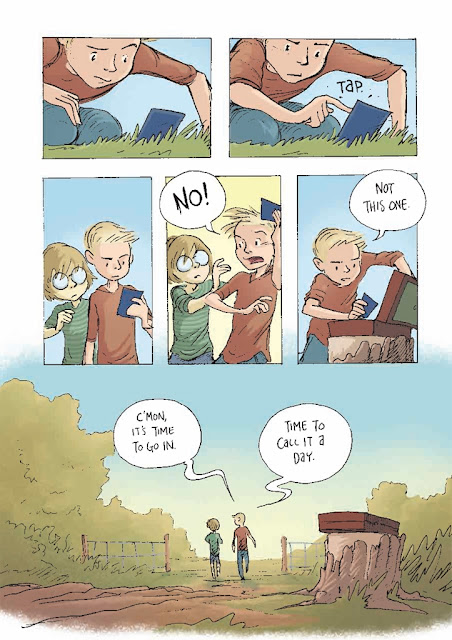
Thinking that the adventure is over, Jack discovers that both Maddy and Lilly have been keeping secrets and a new adventure begins. This time, though, Jack is well equipped with fencing gear and an equally brave and strong partner at his side.
Ben Hatke, fencing!
Source: Review Copy

In 2010, Raina Telgemeier was my introduction to graphic novels. As a bookseller, I was aware of the section with graphic novels for adults and, for the most part they seemed like bleak, dark stories filled with superheroes. Upon seeing Telgemeier's book on the shelf in the kid's section, I was drawn to the mint green cover with the bright yellow, braces filled smiley face of Smile. While I was a bit suspicious, thinking this might be a more superficial story about the awkwardness of braces, I was hooked immediately when I read the first few pages, learning real, autobiographical story behind the braces. Since that day, I have eagerly awaited, read and reviewed all of Telgemeier's books (except Sisters, for some reason) and you can read those reviews here. When I became an elementary school librarian two years ago, one of my first missions was to create a graphic novel section. The shelves currently hold (when they are not checked out, which they always are) ten copies of Smile and Sisters, three copies of Drama and four sets of the four The Babysitter's Club graphic novels, including one set in the newly colored editions. And, once I get my book budget for the year, there will be five library bound copies of Ghosts sitting beside the three paperback copies I bought out of pocket.
Raina Telgemeier has a gift for creating immediately accessible characters who are as colorful and full of life as her vivid illustrations. She also is exceptionally talented at presenting families that, while they have their struggles and conflicts, are connected, supportive, loving and thoughtful. With Ghosts, Telgemeier adds a new layer to her storytelling in the character of Maya, younger sister of main Catrina, who suffers from the degenerative condition, cystic fibrosis. Maya's illness is what causes the family to move from Southern California to the small seaside town in Northern California, Bahía de la Luna. As a native Californian, I love that Telgemeier sets some of her stories here and was so excited to learn that the town of Half Moon Bay was the inspiration for the setting of Ghosts. I also got a kick out of her version of In & Out Burger, a chain restaurant that is only in Southern California.
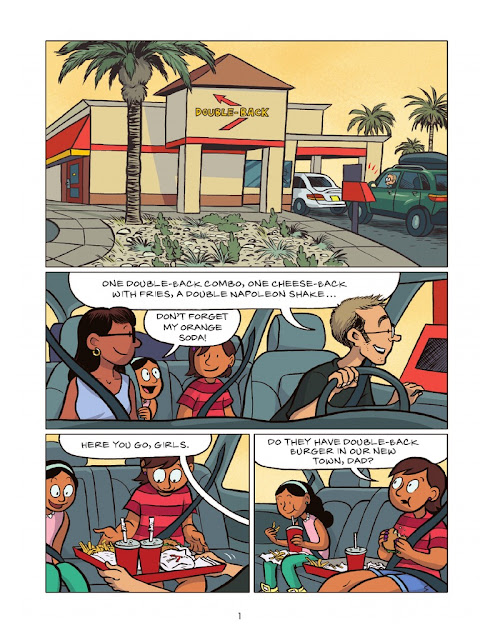
Telgemeier introduces and balances many themes skillfully in Ghosts. There are sibling issues, like Maya's illness and how Cat lovingly protects her but also wants a life of her own, separate from Maya. Then there are family issues that arise as they settle into Bahía de la Luna, which has a large Mexican American population. When the girls learn about Día de los Muertos, the Day of the Dead, which is celebrated with a huge festival and midnight party in Bahía de la Luna, Maya questions her mother about her childhood as a second generation Mexican American. And, with Ghosts, Telgemeier introduces magical realism into her story telling. Carlos Calaveras, neighbor and classmate of Cat's, works as a guide, giving tours of the ghosts of Bahía de la Luna. Cat is suspicious, then furious after she sees that Maya is enthralled with the idea of ghosts and take chances with her health to see one.
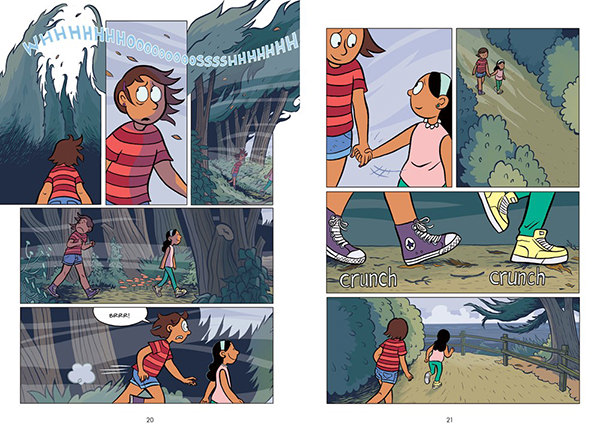
 Cat tries to humor Maya and her excitement over meeting a ghost, but their expedition ultimately puts her in the hospital. Cat spends the rest of the novel coping with her guilt, making new friends, being angry at Carlos and worrying about Maya. Telgemeier ends Ghosts with the marvelous Halloween night, which flows into to the Día de los Muertos celebration where Cat has a change of heart that allows her to make connections with the abuela she never knew, forgive Carlos and make Maya's wish come true.
Cat tries to humor Maya and her excitement over meeting a ghost, but their expedition ultimately puts her in the hospital. Cat spends the rest of the novel coping with her guilt, making new friends, being angry at Carlos and worrying about Maya. Telgemeier ends Ghosts with the marvelous Halloween night, which flows into to the Día de los Muertos celebration where Cat has a change of heart that allows her to make connections with the abuela she never knew, forgive Carlos and make Maya's wish come true.
This is a fantastic trailer that captures the magic of Ghosts!
Raina Telgemeier's books:
Compass South is the fantastic first adventure in the Four Points series of graphic novels written by Hope Larson and illustrated by Rebecca Mock. As I finished reading this book, I felt like I had read a complete novel, there are so many details, world building and character diveristy in this book. In fact, I was reminded of S.E. Grove's trilogy that begins with The Glass Sentence, although Larson's book is set firmly - so far - in real, not an alternative, historical landscape. Mock's illustrations, which are filled with warm earth tones, packed with movement and energy. At times, I had to remind myself of which twin was which, but, in all fairness, this is a story with two sets of redheaded twins!

Set in 1860, Compass South begins with a prologue that explains how and why twins Alexander and Cleopatra Dodge made it from Ireland to New York City with two very special items - a compass and a pocket knife. Twelve years later, the only father they have ever known (but not their birth father) has disappeared and the twins have joined the Black Hook gang, stealing to survive. When Alexander gets caught, he and Cleopatra make a deal that sends them to New Orleans with Luther, a higher up in the Black Hook gang, close on their trail. Luther has been recruited by Felix Worley, also known as Lucky Worley, captain of the black ship, El Caleuche, to find the twins and relieve them of their heirlooms.

These threads alone are enough to keep Compass South moving at a fast pace, but Larson weaves in a few more threads that make the story even richer. Before boarding the train to New Orleans, Alexander sees an add offering a reward for the return of redheaded twins to their father, who went West to find his fortune five years earlier. Alex convinces Cleo to cut her hair so they can pose as Samuel and Jeremiah Kimball and make their way to San Francisco to collect the reward and find their father. Of course things don't go as planned, starting with a run in with red headed twin boys that lands Alex and Edwin back in jail and Cleo and Silas without a plan.
While it's a challenge at times to remember which twin is which, especially after Cleo cuts her hair, the hot head Alex is paired with Silas, who has a mysterious ailment that leaves him weak, while thoughtful Cleo ends up with Edwin, who shares Alex's temperament. I will tell you that the twin pairs both end up on ships, but what happens to them, where they end up and what Luther and Worley want with them, well, you'll just have to read to find out!
Source: Purchased
Compass South is the fantastic first adventure in the Four Points series of graphic novels written by Hope Larson and illustrated by Rebecca Mock. As I finished reading this book, I felt like I had read a complete novel, there are so many details, world building and character diveristy in this book. In fact, I was reminded of S.E. Grove's trilogy that begins with The Glass Sentence, although Larson's book is set firmly - so far - in real, not an alternative, historical landscape. Mock's illustrations, which are filled with warm earth tones, packed with movement and energy. At times, I had to remind myself of which twin was which, but, in all fairness, this is a story with two sets of redheaded twins!

Set in 1860, Compass South begins with a prologue that explains how and why twins Alexander and Cleopatra Dodge made it from Ireland to New York City with two very special items - a compass and a pocket knife. Twelve years later, the only father they have ever known (but not their birth father) has disappeared and the twins have joined the Black Hook gang, stealing to survive. When Alexander gets caught, he and Cleopatra make a deal that sends them to New Orleans with Luther, a higher up in the Black Hook gang, close on their trail. Luther has been recruited by Felix Worley, also known as Lucky Worley, captain of the black ship, El Caleuche, to find the twins and relieve them of their heirlooms.

These threads alone are enough to keep Compass South moving at a fast pace, but Larson weaves in a few more threads that make the story even richer. Before boarding the train to New Orleans, Alexander sees an add offering a reward for the return of redheaded twins to their father, who went West to find his fortune five years earlier. Alex convinces Cleo to cut her hair so they can pose as Samuel and Jeremiah Kimball and make their way to San Francisco to collect the reward and find their father. Of course things don't go as planned, starting with a run in with red headed twin boys that lands Alex and Edwin back in jail and Cleo and Silas without a plan.
While it's a challenge at times to remember which twin is which, especially after Cleo cuts her hair, the hot head Alex is paired with Silas, who has a mysterious ailment that leaves him weak, while thoughtful Cleo ends up with Edwin, who shares Alex's temperament. I will tell you that the twin pairs both end up on ships, but what happens to them, where they end up and what Luther and Worley want with them, well, you'll just have to read to find out!
Source: Purchased
Red's Planet is the first in a comic book series from Eddie Pittman. Pittman, who says he taught himself to draw in the back of math class, has been a professional cartoonist, working in animation, comics and illustration for over 25 years. He has worked on films like Mulan, Tarzan, Fantasia 2000, Lilo & Stitch and The Emperor's New Groove and most recently the show Phineas & Ferb and the influence this work has on his graphic novel is delightfully evident, in both the bright color palette and cinematic sweep of his panels. And, Red's Planet is overflowing with visually fantastic, fascinating characters that I want to get to know better. At first glance, I feel like I can almost begin to guess their back stories. And, while Red's Planet is the first book in the series and almost entirely set up for the rest of the series, every panel of every page is engrossing and exciting. There will be many, many readers waiting for the second book, due out Spring 2017! 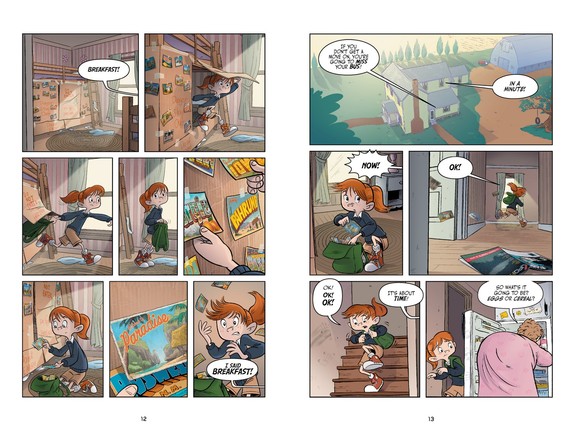
Red's Planet begins with a spooky UFO abduction in the dark of night on a country road. An old guy and his dog are zapped up into a triangular ship and never seen again. This story, "The Mysterious Zeke Hainey Incident," is being read out loud to a roomful of kids by another kid. We quickly learn that Red (we never learn her real name) is one of many foster children, headed down to breakfast and out the door to the bus. Red has intentionally worn non-regulation shoes and tells the kids she is headed home to change. Instead, she plays hooky and ends up in the backseat of a police car in big trouble. Instead of juvie, Red finds herself gone the route of Zeke Hainey.
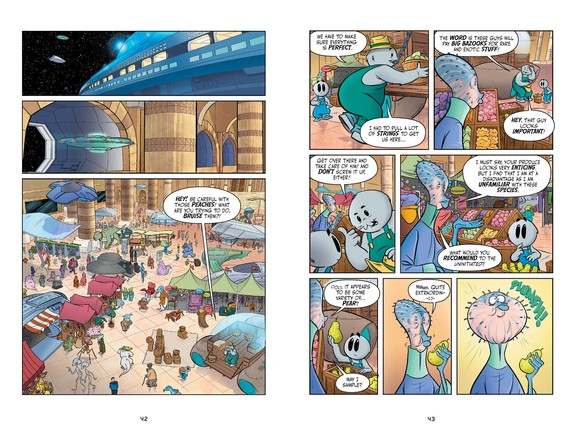
Like all good interplanetary stories, readers find themselves in a bustling marketplace. Here, the Aquilari, "ancients of Chelonia, collectors of time, the last sages of the wandering," and they are on a mission to collect rare items - and creatures. The police car with Red in it, as well as a few other things, make it onto the ship, but things are quickly going pear shaped again for Red as the Uskog pirates demand their treasure, which they believe is on the ship. As battle ensues, the ship veers off course and lands on a dusty planet that Red thinks looks like Texas. A multitude of aliens emerge and begin making sense of things, shunning Red left and right.

Red manages to befriend Tahee, a cute, big-eyed fuzzy guy who, when the ship took off, grabbed a strange glowing egg that he now carries everywhere with him. Red makes some dangerous foes but also a new friend in the crotchety Goose, a feline in a Hawaiian shirt who is sort of a forest ranger for the planet. With his grudging help, she and Tahee manage to get the rest of the aliens to safety, but first they get a glimpse at the amazing cargo that the Aquilari - and their robot boss who, after taking a rock to the head is a bit loopy - are collecting...
Source: Review Copy
Faith Erin Hicks is the author and co-author of two of my favorite YA graphic novels, Friends with Boys and Nothing Can Possibly Go Wrong and now the superb first book in a trilogy, The Nameless City. The Nameless City has the feel of the animated series The Legend of Korra, the spinoff of Avatar: The Last Airbender, both of which I love, and both of which are and will soon be graphic novel series.
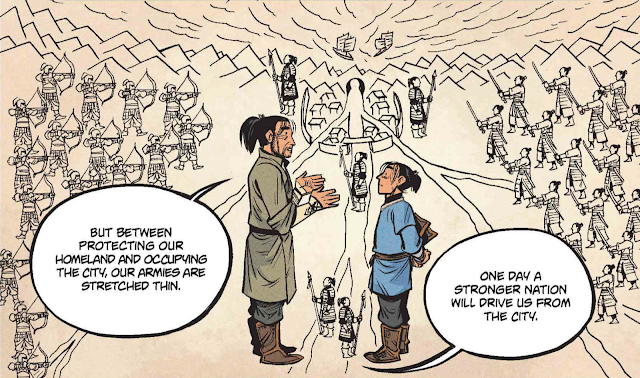
The world of The Nameless City is an ancient one with a vaguely Asian/Egyptian feel to it and her geography is brilliant. The Nameless City sits at the mouth of a great mountain pass where a massive arch has been carved out of the stone, allowing the the River of Lives to reach the sea. On one side of the pass are the Liao and Yisun nations, on the other, the Diao. Because of its location, the Nameless City is forever being invaded by one nation after another, who then changws the name. Eventually it comes to be called the Nameless City by everyone - except the natives, who are referred to as the Named.

Kaidu is from the Dao nation, one of many Dao children sent to the Nameless City to train to be part of military behind the safety of the palace walls. Once there, Kai meets his father, General Andren, for the first time. Andren takes Kai on a walk through the Nameless City, outside the safety of the palace walls, and Kai is clearly shaken by the poverty and homelessness he sees. But, it's also where he first sees Rat, a Named girl who has the remarkable skill of being able to fly across the tops of the tiled roofs of the city and perform a sort of ancient parkour.


Enemies at first, Kai and Rat forge a wary friendship that I think will lead to great changes for all over the course of the trilogy. There are themes of conquest and colonialism that make Rat and Kai's friendship all the more fascinating. The Nameless City, while a long and rich graphic novel, also leaves you feeling like you are just getting to know this ancient place. I can't wait for the second book in the series, The Stone Heart, which, in an interview with the L. A. Times, Hicks promises will be bonkers!
Also by Faith Erin Hicks!
Nothing Can Possibly Go Wrong Source: Review Copy
Human Body Theater: A Non-Fiction Revue, the new graphic novel by Maris Wicks is a fantastic way to learn a vast amount of information in a very fun format. Wicks is the illustrator of one of my favorite non-fiction graphic novels, Primates: The Fearless Science of Jane Goodall, Dian Fossey and Birute Galdikas, written by Jim Ottaviani. In eleven acts, a skeleton takes readers through the main systems of the body, beginning with the skeletal system and working up at the excretory system just before intermission. After that, five more systems are visited, from the endocrine system to the reproductive, immune and nervous systems, ending with the five senses. And, as you can see, Wicks's illustrations are fantastic. Crisp and clear, with a bright color palette and images outlined in black, Human Body Theater is a treat to look at that you will find yourself poring over. 
After a quick introduction to the hardworking stage hands, the cells, bones then muscles are explored. I'll be honest, I have vague memories of learning about the human body in my high school biology class and it was largely uninteresting and forgettable. However, Wicks's illustrations and presentation are so inviting that I genuinely enjoyed my trip through the human body! I guess giving faces and smiles to things like a cytoplasm, a Gogli body and atoms is just entertaining enough to keep my attention. To illustrate how the heart and the lungs work together to supply the body with oxygen, Wicks brings two, pink oxygen molecules in tutus on stage to dance readers through the process.

The Blood Bus takes readers through the cardiovascular system and a peanut butter and banana sandwich explains carbohydrates then, with a note of glee exclaims, "But what's really exciting is that I'm going to get eaten!" The scene ends with the natural conclusion. There is a splash in the toilet on stage and the skeleton thanking the sandwich for an "informative performance." There are also brief forays into heartburn, constipation and the fact that stomach aches, constipation, vomiting and diarrhea can be caused by the brain and the benefits of relaxing and removing stress for the whole body.

 Human Body Theater very tactfully covers the reproductive system, starting with the endocrine system and hormones. Wicks very tactfully uses descriptions rather than depictions for this scene. While there is a sperm and an egg with faces that talk, along with anatomical images of the sex organs, many readers might not even realize what they are looking at. Menstruation and erections are covered along with other changes that puberty brings, like body odor, pimples, hair growth, voice changing and breast development. The scene ends with pregnancy, birth and infancy. After a romp through the five senses, the skeleton ends the show by putting on some skin, then quickly stepping behind the curtain for some clothes.
Human Body Theater very tactfully covers the reproductive system, starting with the endocrine system and hormones. Wicks very tactfully uses descriptions rather than depictions for this scene. While there is a sperm and an egg with faces that talk, along with anatomical images of the sex organs, many readers might not even realize what they are looking at. Menstruation and erections are covered along with other changes that puberty brings, like body odor, pimples, hair growth, voice changing and breast development. The scene ends with pregnancy, birth and infancy. After a romp through the five senses, the skeleton ends the show by putting on some skin, then quickly stepping behind the curtain for some clothes.
In an excellent move, Wicks includes a glossary, with the ASL sign for each letter starting off each section, then a bibliography and suggested reading section!
Besides being a first rate author and illustrator and graphic novelist, Maris Wicks has a background in oceanography and education, having worked at the New England Aquarium where she taught children about marine science. This month she can be found on the R/V Atlantis doing research for the Woods Hole Oceanographic Institution. This all makes perfect sense because Wicks's next graphic novel, coming later this month, can be seen below!
Source: Review Copy
I love it when I find a graphic novel that is as enjoyable as any by Raina Telgemeier, and Awkward by Svetlana Chmakova is right up there, along with Newbery Honor winner Roller Girl by Victoria Jamieson. Chmakova's illustration style is reminiscent of Japanese manga - her characters have exaggerated expressions that add to the humor and emotions of the story. And her color palette is pale yellows, pinks and blues with occasional pops of darker colors. The plot of Awkward shows good kids making bad choices and working hard to making things right. Above all else, the kids in Awkward are creators - they make, they build, they draw. Chmakova ends her wonderful story with these words, "Cardinal Rule #3 for Surviving School: Build. Build things. Build Friendships. Build yourself. Bit by little bit. It may feel like you're not adding that much . . . but in the end, it will add up to a lot."
But, before we get to those wise words, we need to go back about 200 pages to the beginning. Penelope Torres, known as Peppi, is new at Berrybrook Middle School. Not only does she suffer the humiliation of of tripping in the busy hallway and spilling all her books on her first day, overloaded and embarrassed, she makes a bad choice. Peppi's Cardinal Rule #1 for surviving school, "Don't get noticed by the mean kids."
When a friendly student stops to help Peppi, the mean kids start making fun of both of them and Peppi does the unthinkable. Without thinking, she pushes the nice kid and runs off, then regrets it almost every minute of every day afterward.
Struggling in science class, but happily making new friends in art class, Peppi gets caught up in school club drama. The art club and the science club have to compete for the last table at the Club Fair. In the middle of all this, Peppi finds herself trying to apologize to Jamie, the nice kid she pushed, who just happens to be in the Science Club.
Chmakova layers lots of great details and characters into Awkward. There is Maribella, the president of the Art Club, who listens to Peppi's ideas but makes a few bad choices of her own that leave Peppi in a tough spot. There is a great field trip scene at the Natural History Museum and a thread that involves geocaching. And, of course, there are the art and science projects and the teachers who lead these clubs - the harried, paper wasting art teacher, Mr. Ramirez and the super-cool science teacher, Miss Tobins. Best of all, Awkward is not a quick read, which means that you have more time to savor it before starting it all over again.
Source: Purchased Copy
Second only to fairy tales, Greek mythology is a favorite of mine. A few years ago, I created a post featuring reference books, story collections and retellings of The Iliad and The Odyssey for kids that you can read here. And, while I love Greek mythology, I am very picky about what I choose to read, give my kids to read and, now as a school librarian, purchase for my students to read. I am grateful to Rick Riordan for making Greek mythology interesting to kids in a huge way, but I am not always happy with the ways that he tweaks the myths. And, while my personal taste does not keep these books - or the graphic editions - off the shelves, I am thrilled that my students share my taste, making George O'Connor's SUPERB Olympians series of graphic novels the most checked out in my library.
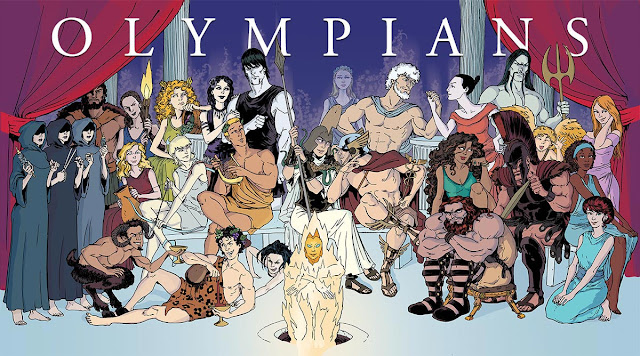
O'Connor is a true scholar of Greek myths and this is evident in each of his books, from the various stories about each god and goddess that he chooses to present in each book to the way he frames these stories and connects them to the excellent back matter, starting with the Author's Note, god/goddess stats, "Greek Notes," which are footnotes that add a wealth of information to the stories, and discussion questions. The frontmatter always includes an extensive Olympians Family Tree. And, while I can't be sure if my students are reading these excellent extras, I do know that they are more likely to consume this information at the end of these graphic novels than they are to pick up D'Aulaire's Greek Myths or other collections, both because of its massive size and outdated appearance. Be sure to visit O'Connor's website, Olympians Rule, where you can read excepts from each book and find more extras to go with each book in the series, like Reader's Theater scripts, an "Add Art or Text" feather that provides a page of illustrated panels with blank speech bubbles OR a page of speech bubbles allowing you to draw in your own gods and goddesses.

O'Connor begins Apollo: The Brilliant One with a quote from The Odyssey, "O Muse! Sing in me, and through me tell a story." Apollo's story begins with one of the Mousai, the nine goddesses of inspiration, or, the Muses. As I read Apollo, I wondered how O'Connor chose the stories that he shares and what order to share them in. Happily, his Author's Note answered that question, which is lengthy but so illuminating. O'Connor writes,
I felt I had to find the thread of what made Apollo compelling, not just as the central character of this book, but as a widely revered god in the ancient world. Ultimately, , inspiration did strike - the nature of the stories told about Apollo is exactly what makes him so interesting to others and to me. He is not some bland, perfect deity; he is conflicted, malicious, and spiteful. He is unknowable in his inhumanity, yet simultaneously relatable. Through research and immersion, the personality of shining Apollo revealed itself to me: an imperfect, proud, brilliant god, resplendent in his glory and unashamed of his pettiness.
For me, O'Connor's description of Apollo also perfectly explains why the Greek myths have endured for thousands of years and are still infinitely interesting and relevant, to both adults and children.
Born of the she-wolf, Leto, and Zeus, Apollo and his twin sister Artemis's birth story is fascinating. As children, they are taken before their father who asked them what "gifts they desired, what they would become." Artemis, who was born first and, in the way that gods and goddesses do, helped Leto deliver her brother nine days later, wants to remain unmarried forever. She wants to hunt with a silver bow and arrows and run wild through the woods with her "own entourage of Oceanides, nymphs and hounds." Apollo refuses to answer. Zeus gives him a "bow to match his sister's. A golden tripod. A chariot pulled by swans to carry him wherever he wished."
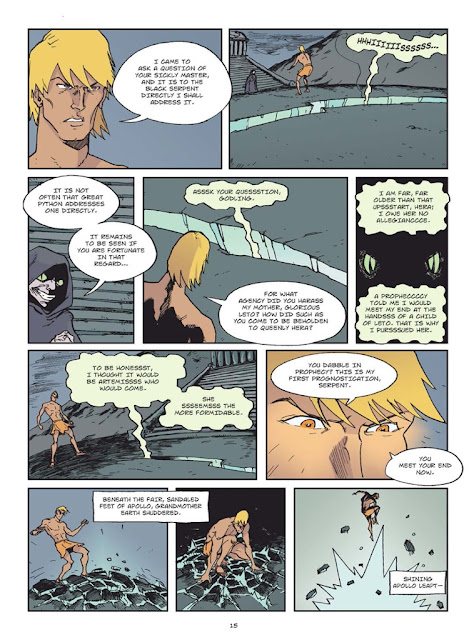
The Muses get a nice bit of page time which includes listing the artistic endeavors they are the inspirations for. The story of Apollo and Daphne, subject of many works of art including Bernini's magnificent sculpture, and the story of Apollo and Hyacinth are both filled with action and emotion. My favorite tale is presented by Clio, the Muse of History, and so much of it is part of our everyday lives today. Apollo fell in love with a mortal woman, the Thessalian princess Koronis. He leaves a white crow to watch over her and, when this crow reports her infidelity, Apollo's rage "scorches the very air around him," which is why all crows are now black. Apollo's ego - and his deep love for his child (another crazy awesome birth story there...) make for a very compelling myth. Turns out, Asklepios, Apollo's son, is raised by Chiron, a centaur and great healer who basically trains Asklepios to be the first human doctor! In turn, Asklepios trains his daughters, Hygeia and Panacea (what what??) to be doctors! Asklepios's sad end is almost as gripping as his strange birth. But I'll leave that for you to discover!
God Stats, found in every book!
Source: Review Copy

I have been half-writing (mostly in my head) a review of the first book in Philip Pullman's masterful trilogy, (known collectively as His Dark Materials) The Golden Compass, originally published in the UK with the title Northern Lights, since I started this blog in 2008. Like the other books that have meant a tremendous amount to me as an adult and/or as a child (Harry Potter, The Phantom Tollbooth) I have not reviewed them here, either because I wasn't sure I could add anything new to the conversation or because the task was too overwhelming. A review of Pullman's almost 20 year old book falls into both categories. Contemplating writing a review of this philosophically provocative, theologically challenging brilliant work of fantasy (really - dæmons? The best fantastical creation ever!!) feels comparable to starting my thesis senior year of college. What follows is a review of the graphic novel with a brief synopsis of the plot of the graphic novel adaptation (but not the whole book) for readers who have not had the immense pleasure of reading this trilogy yet. For an encompassing review of all three books in one, read Brian Anderson's review of The Amber Spyglass for the New York Times.

But, as a fan of the graphic novel, I think I just might have something to say about this new adaptation of Pullman's work. First of all, I think that the only logical choice was to have this illustrated adaptation creation taken on by the French. I learned years ago that the French love, love, love and have deep respect for the art of the graphic novel. And, last summer over the course of a few days in Paris, I visited many bookstores and several spent hours in the graphic novel sections regretting the fact that I had forgotten all of my high school French but marveling over all the gorgeous, inventive visual storytelling. Another smart choice was made when this book was divided into three volumes, with books 2 and 3 coming out in September 2016 and 2017.

I also think that I am perfectly poised to review the graphic novel adaptation of The Golden Compass because I first read the trilogy about 16 years ago, just before the third and final book, The Amber Spyglass, was published. Since then, I have listened to the fantastic audio production of the trilogy (including a full cast with Pullman himself narrating) a couple of times. So I remember the book, but not enough to get really picky about the adaptation itself, which would detract from enjoyment of the graphic novel. Of course aspects of the plot have to be simplified and speeded up because this is a graphic novel - and because of the complexity of the themes. Melchior, who also wrote the graphic novel adaptation of The Great Gatsby (Gatsby le Magnifique) does a fine job explaining the fantasy elements of the novel, like dæmons, the alethiometer and panserbjorne, while Oubrerie's illustrations bring the familiar but strange world of an England and Northern Europe to life. For me, Pullman's novels are so richly magical and polished (they are often ranked alongside the works of C.S. Lewis and Tolkein) that I think I might have imagined a more lush illustration style, like that of Kazu Kibuishi. But, Oubrerie's scratchy, kinetic style captures the almost feral nature - and enthusiasm - of Lyra and the archaically civilized world of Jordan College that brushes - sometimes roughly - against the natural world around them and the various tribes that inhabit it.

Of course there are aspects of the novel that I found missing in this graphic adaptation, but this is also a three part adaptation of a single book. I am hopeful that things I noticed missing - like the compelling relationship between dæmons and their humans - will be explored in the next book as we move closer to Svalbard and the Northern Lights. However, as sometimes only a graphic novel can do, there are winks and nods as well. In one scene, Lyra and Pan are in the heart of the city at night and they pass a theater where John Milton's Paradise Lost is being performed, a nod to the title of the trilogy, taken from Book 2 of Milton's epic poem.

The Golden Compass: The Graphic Novel, Volume 1 begins with a zeppelin hovering over Oxford, preparing to dock at Jordan college where Lord Asriel, the great explorer, is due to give a talk about his travels in the North. Hiding in a cupboard with her dæmon Pantalaimon, is Lyra Belacqua. So much happens in this one scene - Lyra saves Lord Asriel, a man she believes is her uncle and benefactor, from being poisoned. She also overhears Asriel's discussion of Dust and the appearance of another world through the glimmering Northern Lights. From that night, the story takes off at a fast pace. The head of Jordan College sends Lyra off to live with Mrs. Coulter, an elegant explorer with connections to people in high places, such as the Magesterium and the General Oblation Board, also known as the Gobblers. Before Lyra leaves Jordan College, the Master gives her the alethiometer, a golden compass that Lord Asriel entrusted to him, telling her to keep it hidden. When Mrs. Coulter's dæmon finds it, Lyra and Pan make a quick escape. A dangerous night leads them to a gyptian boat and safety. Hidden amongst this community that has lost many of its children to the Gobblers, Lyra finds her place and a deeper understanding of the alethiometer as they sail towards the North to make a dangerous rescue.
Book 2 of The Golden Compass Graphic Novel, coming September 2016
(the French cover, which reflects the original British title, The Northern Lights)
Melchior's graphic novel adaptation of
The Great Gatsby
I can't ever imagine getting tired of Barry Deutsch's self-possessed, stubborn heroine or the slightly As one review succinctly, perfectly signed off, "This consistently clever and thoughtful series has not lost a particle of momentum." One of my favorite little things that comes with each new book is the new tagline! For book three in this brilliant series,
Hereville: How Mirka Caught a Fish, the it reads, "Yet Another 11-Year-Old Time Traveling Orthodox Jewish Babysitter." As always, Deutsch's books are a marvelous mash-up of a fairy-tale-fantasy world and an Orthodox Jewish community. With book three, we get a glimpse into the world of Fruma, Mirka's stepmother.Just before leaving Mirka home alone to babysit her little sister Layele, her stepmother Fruma drops some cryptic comments about happenings in the woods near their home. Tasked with doing the Shabbos shopping at Hershel's Grocery, Mirka drags a frightened Layele into the woods first so that she can get help in finding out what Fruma meant. A very funny scene with the troll Mirka fought in the first book ends with a magic hair tie that affords Mirka and Layele to see Fruma as a teenager. A non-Orthodox teenager!

A magic fish, a wish made by teen-Fruma and a tricky second wish that traps the fish cause trouble for Mirka and Layele, who finds herself the vessel for the fish at one point. The fish is determined to exact revenge on Fruma and Mirka finds that she has to use her brain and her empathy instead of her sword to outwit the vindictive fish. Mirka is a compelling character both because of her flaws and her strengths. She is headstrong and determined and always breaking rules and disregarding her elders, and for this I love her. But what I love even more is watching Mirka think (and fight) her way to redemption and success.
Books 1 & 2 in the Hereville Series:
Source: Review Copy
Binary code. Computer programming. New town and new school. Gene Luen Yang, graphic novelist extraordinaire, is great storyteller, whatever subject he focuses on. Yang moves with ease from literary historical fiction like Boxers & Saints, to superheroes, like The Shadow Hero, Avatar, the Last Airbender and Superman, and on to everyday life, like Level Up, American Born Chinese, and The Eternal Smile. As a former high school computer science teacher, who made comics at night, Yang is a big supporter of teacher kids to code at an early age and his newest graphic novel series, Secret Coders: Get With the Program!, created with Mike Holmes, bringing what Yang calls a "Saturday morning energy" to it, does just that.is designed to do just that. There is even an excellent website for the book filled with great instructional videos, coding activities, including a downloadable file that lets you create Little Guy, the robot from the book, on a 3D printer! Stately Academy, the setting of Secret Coders: Get With the Program!, is a bit like Hogwarts. As Yang says, it's a secret school that "teaches coding instead of magic." And, as Yang points out, coding is even better than magic because you can do it at home! Hopper is new to the slightly creepy, sort of mysterious Stately Academy. She gets pudding chucked at her head, makes a fool of herself in Mandarin class and at lunch her earrings, shaped like the number 7, trigger a startling reaction in a weird bird.

Seeing this oddity, Eni, son of a software engineer, comes over to investigate. Besides having some mad skills on the basketball court, Eni has a solid grasp of binary numbers and explains the controlling binary code to Hopper with a cool demonstration using pennies and chalk. Once Hopper gets it, the two experiment on the bird and begin to understand why the number 9 appears all over the school. There seem to be secret codes everywhere at Stately Academy and as Eni, his buddy Josh and Hopper break them they travel deeper and deeper into the secrets of the school and the crusty old janitor, Mr. Bee.
 Some secrets are exposed and even more are unearthed by the end of Secret Coders: Get With the Program!, which has a bit of a cliffhanger. Book 1 is a great set up, focusing on making sure that readers understand binary code (over more character and plot development) before moving on to the next book in the series, Secret Coders: Paths & Portals, which comes out in January of 2016!
Some secrets are exposed and even more are unearthed by the end of Secret Coders: Get With the Program!, which has a bit of a cliffhanger. Book 1 is a great set up, focusing on making sure that readers understand binary code (over more character and plot development) before moving on to the next book in the series, Secret Coders: Paths & Portals, which comes out in January of 2016!
Source: Review Copy
Jane, the Fox and Me is a graphic novel by Fanny Britt, illustrated by the marvelous Isabelle Arsenault, but it feels like something different. The trim size of Jane, the Fox and Me is big, like a picture book. The handwritten text shifts from block letters to cursive to a delicate font just as the story shifts between worlds when Hélène, the young hero of the story, moves between the worlds of school, home and her inner life, fueled by her literary explorations that shape how she sees the world. Like the grey and sepia tones of most of Aresnault's illustrations, Hélène's worlds are bleak. School is a lonely landscape where she is taunted by mean girls. Flashbacks reveal that it wasn't always this way, once she had friends and was part of a group of girls who loved shopping vintage stores for crinoline dresses. Home is not much better, with her younger twin brothers and her overworked mother. Escape comes in the pages of Jane Eyre and the world of Thornfield Hall. 


Everyone knows that kids are mean and will find (or create) a weakness in another child to prey on. Hélène's former friends ostracize her because of how she looks, writing graffiti on the walls of the bathroom about her weight and body odor. Britt handles this delicate subject with simplicity and honesty that speaks to the core of any girl who was (is) not slender and hopefully opens the eyes to those who are. Britt crystalizes the experience of being overweight when Hélène learns that her class will be going to nature camp, necessitating the purchase of a new swimsuit and her only options are a ruffled, skirted suit and one that is "all black and sad." Hélène sees herself as a sausage in a swimsuit.
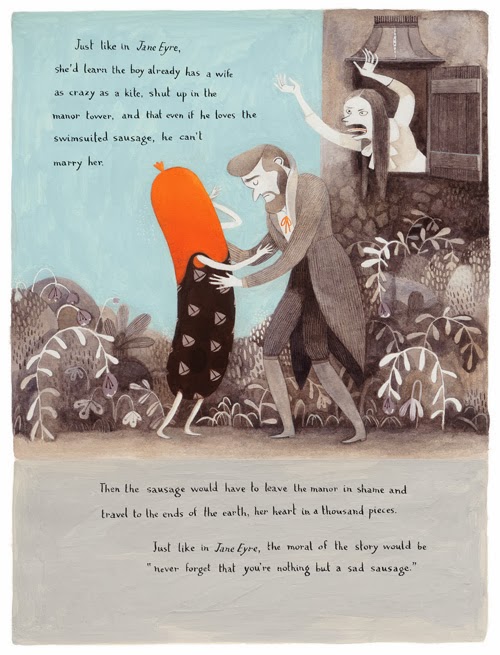
Hélène departs, "on a bus to Lake Kanawana with forty kids in shorts, not one of them a friend." The mean girl, fat shaming escalates at camp, where Hélène ends up in the outcasts' tent, believing that the moral of Jane Eyre and her own story is, "never forget that you're nothing but a sad sausage." When things seem at their lowest for Hélène, Géraldine appears and a friend is made. And, while Hélène finally finding a friend again is a wonderful plot thread, I especially appreciated how Britt ends Jane, the Fox and Me, with a visit to the doctor for an annual exam. Stepping on the scale, Hélène sees that she weighs less than the graffiti, but more than last year and claps her hands to her head and shrieks, the way she sees her mother (and the lady in the cereal ad) do when she steps on the scale. She tells the doctor that she is fat and the doctor tells her she is no such thing. Her mother asks where she ever got the idea that she was fat and, in her head Hélène ticks off the many places, including her own mother, but does not say them out loud. She realizes that the less she thinks about what other people say about her, the less it is true. I wish that every lonely, book loving, less that slim young girl could read Jane, the Fox and Me and think less about what is not true.

Source: Purchased at Porter Square Books
in Somerville, MA
The Stratford Zoo Midnight Review series by Ian Lendler and Zack Giallongo is going to do for Shakespeare what George O'Connor has done for Greek mythology with his Olympians series. Last year they debuted, The Stratford Zoo Midnight Review Presents: Macbeth, and now, as promised by the peacock at the end of Macbeth, The Stratford Zoo Midnight Review: Romeo and Juliet has arrived!
The Stratford Zoo Midnight Review Presents: Macbeth takes a pretty intense, adult play about a thirst for power, a prophecy and more than a few murders and, miraculously, makes it kid appropriate. As The Stratford Zoo Midnight Review Presents: Macbeth begins, there is a quick set up where readers see a pink, tentacle-y arm unlocking cages all over the zoo and the audience taking their seats while seagulls hawk "Peanuts! Earthworms! Ice cold bananas!" and, "Carrion, rotting carrion!" Panels, sometimes strategically placed, allow glimpses of the audience and their reactions as the play unfolds.

Macbeth, as played by the lion, is adored by all, plied with food and hungry for something new. He realizes that if he eats the king he will become the new king. It's not food Macbeth wants, it's power! Loads of ketchup and an elephant getting up out of his seat disguise the murders that Macbeth commits to become and stay king. Lady Macbeth, as played by a cheetah, realizes, most dramatically, that her spots just will NOT come out (and a key word in her famous speech about them is changed to "dumb.") MacDuff, as played by a stork, defeats Macbeth, fulfilling the prophecy because he wasn't born from a mother, but "delivered," and, happily, everyone that he has eaten in his quest for power pops out of his mouth! The actors take a bow, the audience leaves and, as the zoo opens we see kids wondering what the animals do all night, since they seem to sleep all day...

In The Stratford Zoo Midnight Review: Romeo and Juliet the animal actors return with another of Shakespeare's tragedies and a rooster and a bear in the titular roles. The same family of monkeys return for the play, and the little one quips and complains and tussles with a lamb, Lydia, but ultimately enjoy the play and find friendship after the curtain closes, echoing that action on the stage. The writing and casting of The Stratford Zoo Midnight Review: Romeo and Juliet is brilliant. Romeo and the Montagues are roosters (and chickens) and part of the Verona Petting Zoo and known as "Petters." The Capulets are Wilders, bears living in the wilderness. The two meet at a costume party where Romeo is wearing a bandit mask and Juliet is dressed as (a very cute) Abraham Lincoln. Lendler gets around the love, marriage and death aspects of the story by having Romeo and Juliet want to be best friends and Juliet deciding to enter into early hibernation.

 Giallongo's illustrations are bright and colorful and hilarious. The plans for Juliet's party include juice boxes and a blow-up bounce house. The Stratford Zoo Midnight Review: Romeo and Juliet is a more brightly colored book, perhaps because of the roosters. Once again, the violence and death is tactfully handled by having an elephant in the audience - this time with a date in tow - stand up and block the stage. The story and art work together perfectly, once again, in this totally entertaining graphic novel. Kids don't need to know that they are reading a Shakespeare play to enjoy or understand the story - it works on its own. The bonus is, maybe 5 years down the road when they read the play in high school, they will already know the story! Once again, the zookeepers clean up after the play, baffled by a bottle of "Hibernation Juice" they discover amongst the trash. The next play/graphic novel promises to be a comedy and I can't wait to read it.
Giallongo's illustrations are bright and colorful and hilarious. The plans for Juliet's party include juice boxes and a blow-up bounce house. The Stratford Zoo Midnight Review: Romeo and Juliet is a more brightly colored book, perhaps because of the roosters. Once again, the violence and death is tactfully handled by having an elephant in the audience - this time with a date in tow - stand up and block the stage. The story and art work together perfectly, once again, in this totally entertaining graphic novel. Kids don't need to know that they are reading a Shakespeare play to enjoy or understand the story - it works on its own. The bonus is, maybe 5 years down the road when they read the play in high school, they will already know the story! Once again, the zookeepers clean up after the play, baffled by a bottle of "Hibernation Juice" they discover amongst the trash. The next play/graphic novel promises to be a comedy and I can't wait to read it.

Source: Purchased (Macbeth) and Review Copy (Romeo & Juliet)
Sunny Side Up by Jennifer L. Holm and Matthew Holm is a magnificent semi-autobiographical graphic novel that can stand next to the works of Raina Telgemeier and Newbery Honor winner, Cece Bell, author of El Deafo. Based on book sales and the check out rate of these titles in my school library, girls and boys are hungry for graphic novels like Smile, Drama and Sisters that tell the stories
Blankets by Craig Thompson was one of the first graphic novels I read. Over the course of a week, during lunch breaks while I worked at the bookstore, I consumed this 592 page adult graphic novel and was astounded at what a moving, intimate experience reading this book proved to be. Thompson followed up Blankets with Habibi, an epic story that begins with a nine-year-old girl being sold
Baba Yaga's Assistant is the superlative new graphic novel written by Marika McCoola and illustrated by Emily Carroll, who brought us the eerily wonderful graphic Through the Woods. I am a HUGE fan of fairy tales (my secret dream is to get a PhD in fairy tales and write a killer dissertation...) and always excited to see a story that features one of the lesser known (to Americans) characters
In a brilliant move, Scholastic had Raina Telgemeier turn Ann M. Martin's hugely successful (but gently out of date) series The Baby-Sitters Club into a (black and white) graphic novel in 2006. It took almost 10 years and two best selling graphic novels penned by Telgemeier herself for Scholastic Graphix to add color to the four books in this series, which will be released over the course
Roller Girl is the absolutely magnificent debut graphic novel by picture book author and illustrator Victoria Jamieson. Jamieson has an inviting, crisp illustration style and a gift for storytelling that rivals the master, Raina Telgemeier. With Roller Girl, Jamieson introduces readers to Astrid, a 12 year-old who discovers her passion the same summer she discovers the complexities and
Entomologist, biology professor, cartoonist. Not necessarily three professions you expect in one person, but Jay Hosler, author of Last of the Sandwalkers is all three as well as an award winning graphic novelist. With Last of the Sandwalkers, Hosler creates a completely absorbing story that feels a bit like A Bug's Life meets Indiana Jones and the Temple of Doom distilled into a
Cece Bell's graphic novel memoir, El Deafo, with color by David Lasky, tells the story of losing 80% of her hearing at age four and has been getting a lot of well deserved advance attention. The review copy boasts stellar blurbs from, among others, R.J. Palacio, author of Wonder, and Raina Telgemeier, author of the graphic novel, Smile. Palacio, Telgemeier and Bell's amazing books about
 Cat tries to humor Maya and her excitement over meeting a ghost, but their expedition ultimately puts her in the hospital. Cat spends the rest of the novel coping with her guilt, making new friends, being angry at Carlos and worrying about Maya. Telgemeier ends Ghosts with the marvelous Halloween night, which flows into to the Día de los Muertos celebration where Cat has a change of heart that allows her to make connections with the abuela she never knew, forgive Carlos and make Maya's wish come true.
Cat tries to humor Maya and her excitement over meeting a ghost, but their expedition ultimately puts her in the hospital. Cat spends the rest of the novel coping with her guilt, making new friends, being angry at Carlos and worrying about Maya. Telgemeier ends Ghosts with the marvelous Halloween night, which flows into to the Día de los Muertos celebration where Cat has a change of heart that allows her to make connections with the abuela she never knew, forgive Carlos and make Maya's wish come true. Human Body Theater very tactfully covers the reproductive system, starting with the endocrine system and hormones. Wicks very tactfully uses descriptions rather than depictions for this scene. While there is a sperm and an egg with faces that talk, along with anatomical images of the sex organs, many readers might not even realize what they are looking at. Menstruation and erections are covered along with other changes that puberty brings, like body odor, pimples, hair growth, voice changing and breast development. The scene ends with pregnancy, birth and infancy. After a romp through the five senses, the skeleton ends the show by putting on some skin, then quickly stepping behind the curtain for some clothes.
Human Body Theater very tactfully covers the reproductive system, starting with the endocrine system and hormones. Wicks very tactfully uses descriptions rather than depictions for this scene. While there is a sperm and an egg with faces that talk, along with anatomical images of the sex organs, many readers might not even realize what they are looking at. Menstruation and erections are covered along with other changes that puberty brings, like body odor, pimples, hair growth, voice changing and breast development. The scene ends with pregnancy, birth and infancy. After a romp through the five senses, the skeleton ends the show by putting on some skin, then quickly stepping behind the curtain for some clothes.
 Some secrets are exposed and even more are unearthed by the end of Secret Coders: Get With the Program!, which has a bit of a cliffhanger. Book 1 is a great set up, focusing on making sure that readers understand binary code (over more character and plot development) before moving on to the next book in the series, Secret Coders: Paths & Portals, which comes out in January of 2016!
Some secrets are exposed and even more are unearthed by the end of Secret Coders: Get With the Program!, which has a bit of a cliffhanger. Book 1 is a great set up, focusing on making sure that readers understand binary code (over more character and plot development) before moving on to the next book in the series, Secret Coders: Paths & Portals, which comes out in January of 2016!
 Giallongo's illustrations are bright and colorful and hilarious. The plans for Juliet's party include juice boxes and a blow-up bounce house. The Stratford Zoo Midnight Review: Romeo and Juliet is a more brightly colored book, perhaps because of the roosters. Once again, the violence and death is tactfully handled by having an elephant in the audience - this time with a date in tow - stand up and block the stage. The story and art work together perfectly, once again, in this totally entertaining graphic novel. Kids don't need to know that they are reading a Shakespeare play to enjoy or understand the story - it works on its own. The bonus is, maybe 5 years down the road when they read the play in high school, they will already know the story! Once again, the zookeepers clean up after the play, baffled by a bottle of "Hibernation Juice" they discover amongst the trash. The next play/graphic novel promises to be a comedy and I can't wait to read it.
Giallongo's illustrations are bright and colorful and hilarious. The plans for Juliet's party include juice boxes and a blow-up bounce house. The Stratford Zoo Midnight Review: Romeo and Juliet is a more brightly colored book, perhaps because of the roosters. Once again, the violence and death is tactfully handled by having an elephant in the audience - this time with a date in tow - stand up and block the stage. The story and art work together perfectly, once again, in this totally entertaining graphic novel. Kids don't need to know that they are reading a Shakespeare play to enjoy or understand the story - it works on its own. The bonus is, maybe 5 years down the road when they read the play in high school, they will already know the story! Once again, the zookeepers clean up after the play, baffled by a bottle of "Hibernation Juice" they discover amongst the trash. The next play/graphic novel promises to be a comedy and I can't wait to read it.























